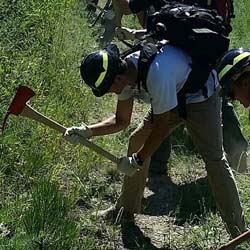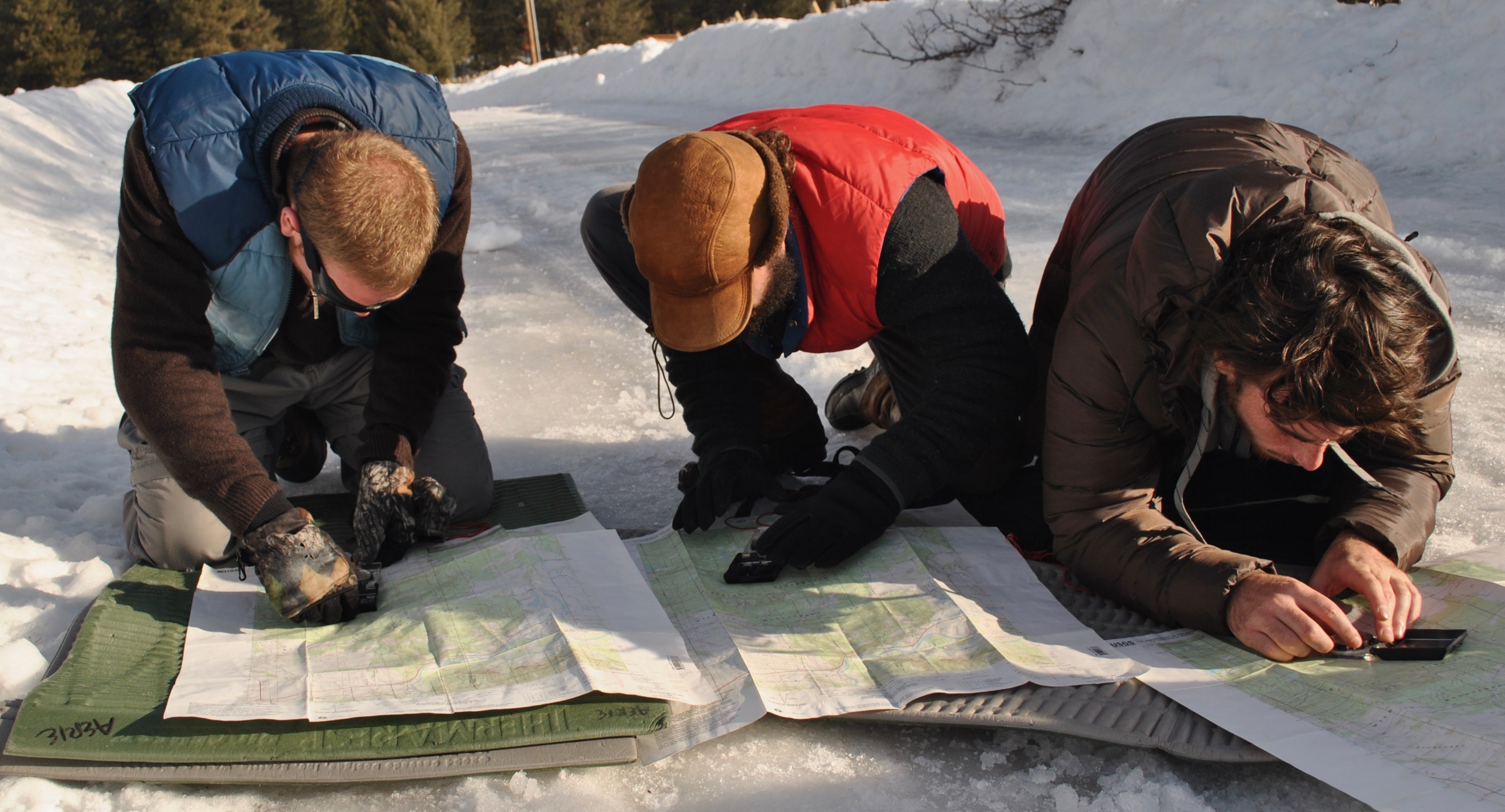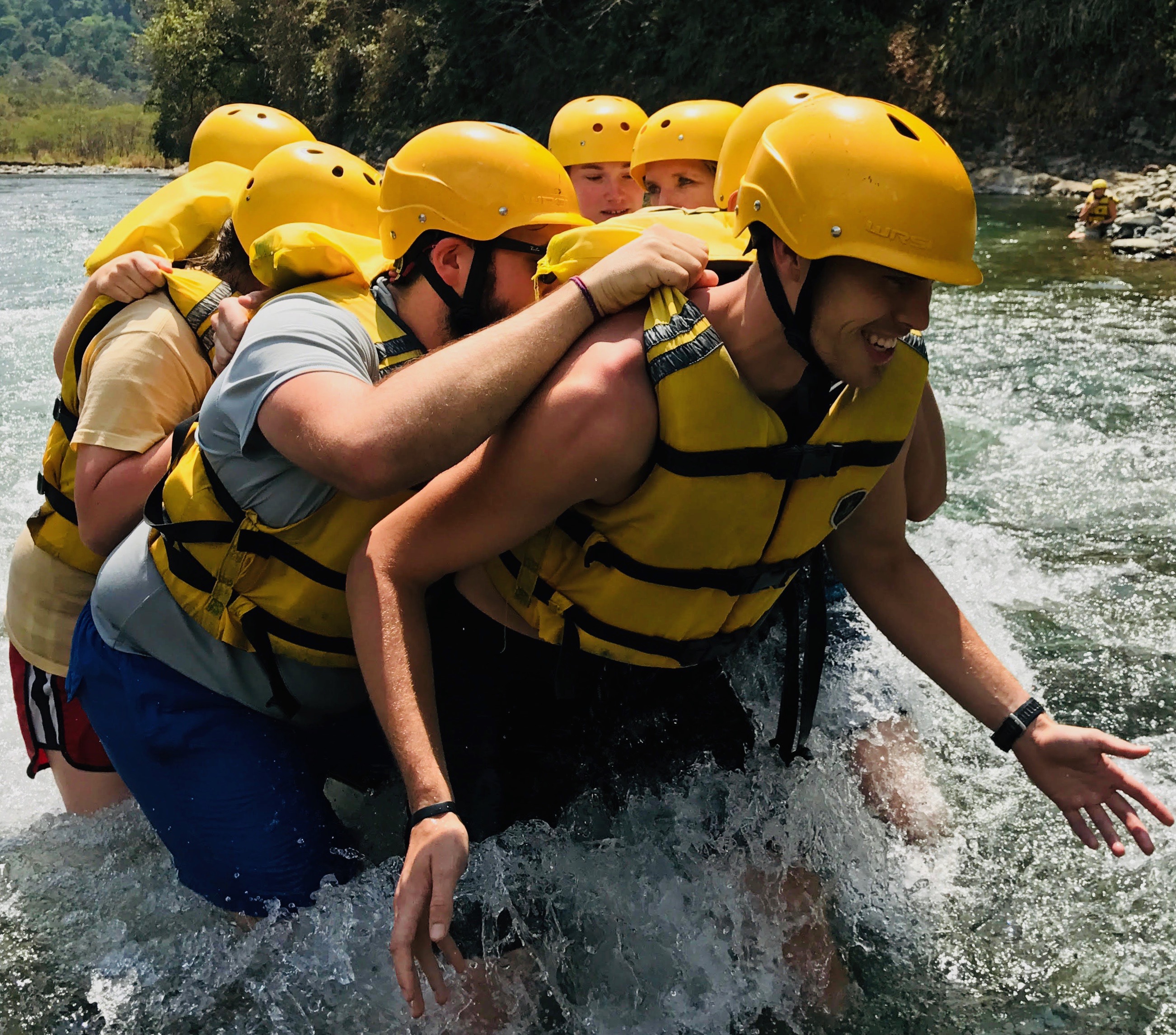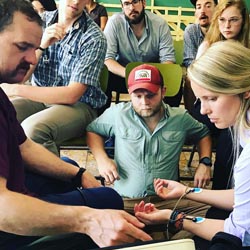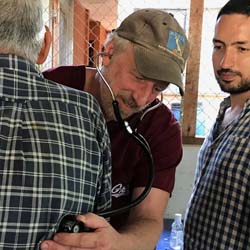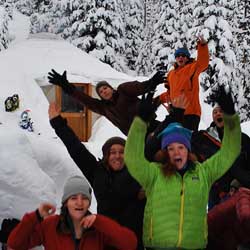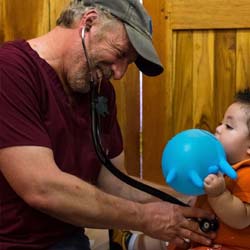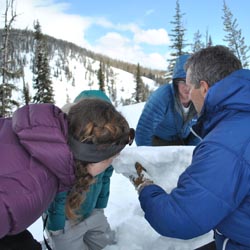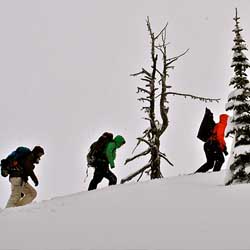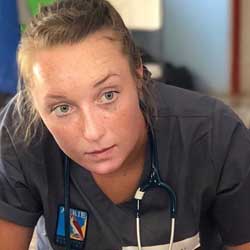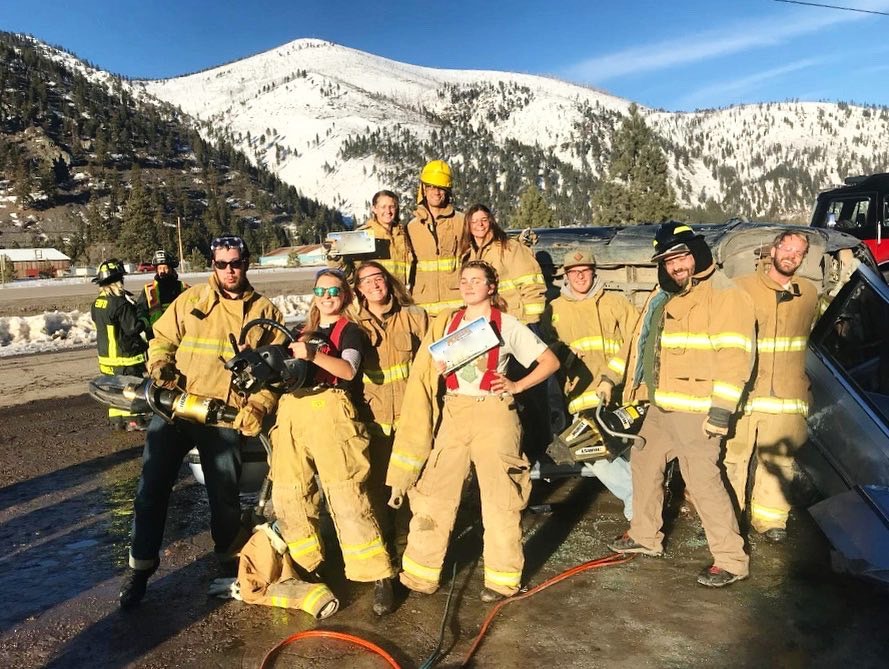Overview
Aerie's Spring Semester provides unparalleled opportunities to learn and practice wilderness medicine and rescue skills in both the lush Costa Rican rainforest and the snowy Montana Rockies.
The program begins with 4+ week intensive in Costa Rica, beginning at the beautiful Rancho Mastatal, where you will complete most of your EMT training and then immediately use that training to help organize and run a series of free health clinics in rural Costa Rican villages. Aerie partners with several Costa Rican physicians whose focus is rural medical care. These clinics give you hours of practice assessing actual patients under the direction of U.S. and Costa Rican doctors.
The program will have a brief recess to allow students to travel back to the United States and make their way to Montana. Lodging and food are provided in Missoula during the recess, there will not be any mandatory course curriculum.
Upon your return to Montana, you will begin your American clinical experience. During this intense period, you will shadow physicians and nurses in the emergency room at St Patrick Hospital and complete observational ride-alongs with paramedics at Missoula Emergency Service's Advanced Life Support ambulance. In addition, you will spend an afternoon with Missoula City Fire Department's Extrication Team learning the art of vehicle extrication, and another afternoon enhancing your understanding of human anatomy and physiology in the cadaver lab at the University of Montana. During breaks in those activities, you will spend time on the University of Montana campus preparing for the practical and written final EMT examinations.
Once you complete your clinicals in Missoula, you and your fellow teammates will travel to the stunning Swan Valley, about 60 miles north of Missoula, to begin ten days of avalanche rescue, outdoor leadership, and wilderness survival and navigation training. During this time, you will earn your Recreation Avalanche 1 certification. When digging in the snow, it may be hard to remember that just a week before you were rescuing patients out of a warm Costa Rican river, but that is the essence of the Spring Semester. Environments do not change medicine, but the opportunities and obstacles provided by each environment are unique and require specialized training and preparation.
After completing avalanche training, you will return to the Rich Ranch, at the base of the mountains, and continue with your Search and Rescue and wilderness EMT training. At this lower elevation, as the snow recedes, you will complete your Red Card Wildland Firefighting training with Aerie's professional wildlands firefighting instructors. The program culminates with you putting your route-finding, wilderness medical treatment skills, and team work to the test in an overnight RATRACE (Reach And Treat Review And Comprehensive Exam) adventure race, where you will be evaluated on all skills learned in the program. At the conclusion of the RATRACE, you will have truly earned every certification, credit and experience you have gained.
Credits & Certifications*
- 15 upper-division University of Montana credits
- Aerie Wilderness Emergency Medical Technician (W-EMT) certification
- National Registry EMT (EMT) certification
- State of Montana EMT certification (optional)
- American Heart Association BLS CPR certification
- Red Card Wildland Firefighting certification
- Recreation Avalanche Level 1 certification
- Swiftwater Rescue Technician (SRT) certification
- Introduction to Search and Rescue certification
- Leave No Trace Trainer certification
*Earning credits and certifications is dependent on successful completion of required physical and practical examinations as well as final payment of tuition.
For more information on the certifications, including recertification requirements, please read through the FAQ tab.
For a general overview of the credits offered through the Semester, click here. University credits consist of three separate 5-credit upper-division courses from the University of Montana: Emergency Medical Technician and Incident Management; Wilderness Medicine and Risk Management; and Wilderness Rescue and Survival Skills. Our students receive official transcripts from the University of Montana for Semester coursework.
To transfer credits to your university, you will need to get approval from your advisor and possibly your university's registrar. Most schools allow transfer of credits from other degree-granting institutions. Assuming your university will accept transfer credits from UM, your advisor will need to make a determination about HOW the credits will transfer to your degree. They may come in as upper-division electives, or your advisor may agree to use them towards a specific degree requirement. Please write us for more information, and feel free to forward the syllabi above to your advisor for review.
Locations
Check out the list of amazing host facilities here:
- Rancho Mastatal, Costa Rica
- Missoula College, Missoula, MT
- Rich's Montana Guest Ranch, Seeley Lake, MT
- Whitewater Rescue Institute, Alberton, MT
Dates
February 1st - April 12th, 2025
Costs
$17,000 program cost includes the following:- The following certifications:
- EMT and Wilderness EMT
- American Heart Association BLS CPR
- Red Card Wildlands Firefighting Certification
- Swiftwater Rescue Technician Certification
- Rope Rescue Technician Certification
- Search and Rescue Certification
- Leave No Trace Trainer Certification
- Course texts ($125):
- Aerie Wilderness Medicine
- Swiftwater Rescue
- Rope Rescue
- Leave No Trace
- AMC Guide to Outdoor Leadership
The following items are NOT included with tuition:
- Registration fee for 15 upper division credits from the University of Montana (optional - approximately $500)
- EMT text book (approximately $100)
- National Registry of EMT on-line registration and computer testing fee (approximately $100)
- State of Montana EMT licensure (optional - approximately $50)
- Health insurance
- Any costs associated with early departures or personal medical emergencies - including shuttles to and from medical care.
Scholarships/ discounts
Please contact our Semester Coordinator, James Pyke, if you are eligible for any of the following:
- Early-Bird Registration
- $2,000 tuition discount for any student paying their non-refundable $2,000 deposit 6 months or more before the start of the program.
- Students may be eligible for no more than one of the following tuition discounts:
- AmeriCorps members/alumni using their AmeriCorps awards will have their awards matched, up to $3,000 or
- AmeriCorps members/alumni without education awards - $3,000 tuition discount or
- Alumni or staff of the following: Student Conservation Association, American Conservation Experience, and any other state Conservation Corps or Youth Corps programs - $3,000 tuition discount or
- Montana-state residents or students enrolled at a Montana college - $3,000 tuition discount
Students may also be able to use the following:
Federal Financial Aid (FAFSA)
Because Aerie's Spring Semester program is offered through the University of Montana, students who are currently receiving federal financial aid using the FAFSA are often able to use their financial aid to pay for Semester tuition. Aerie can help facilitate this process. The process for doing this is described here. Contact Semester Coordinator, James Pyke, with any questions.
AmeriCorps Awards
Because the program is run through an accredited Title IV university, AmeriCorps members and alumni can use their Segal Education Awards to pay for their tuition. If you have completed more than one AmeriCorps program, you are able to use all your awards, cumulatively, for tuition. The process for doing this is described here. Contact Semester Coordinator, James Pyke, with any questions.
Clinical Experience
Aerie's Semesters are, above all else, about the medicine. Our students complete their education and training with more clinical experience and practice than you can get anywhere. We believe excellent patient assessment and care is at the heart of all other advanced skills. Aerie Semesters not only offer extensive practice for EMT skills, leading to universally high rates of National Registry certification, we also provide actual patient assessment experience in professional settings.
During the semester, you may ride along with paramedics and EMTs on an Advanced Life Support Ambulance during a 12-hour shift. You may also work a 12-hour shift in the emergency department of St Patrick Hospital. For the spring of 2022, we will keep students up to date on our local hospital and ambulance regulations concerning clinical rotations in the time of COVID. Check with Coordinator James Pyke if you have questions.
F.A.Q.
Q: Will I have time off during the program for personal travel or recreation?
A: Very little. You should plan to come to the program early or stay afterwards for personal recreational travel of more than a day.
Q: Will there be tests and homework?
A: Yes. Homework is assigned each night and initially may include up to 100 pages of reading per night. At least two written exams are given each week in addition to a weekly practical exam.
Q: What does the optional "online coursework" consist of?
A: Because of the heavy reading load in the National Registry EMT text, we assign two chapters of reading and associated online quizzes during each of the three weeks preceding the start of the Semester. Students can complete this work wherever they happen to be, as long as they have internet access to submit their quiz answers. While this online coursework is optional for Spring students, we highly encourage students to complete this section to be in the best position for success.
Q: What are Aerie's academic expectations?
A: High. Aerie's course policies outline our academic expectations; you will be given a handbook outlining our course policies once you have been accepted into the Semester. Students must receive passing grades on weekly exams to be eligible to test for the National Registry final exam; this is not an Aerie policy – it is a National Registry policy. Poor grades may result in expulsion from the program and may result in not being able to test for, or receive, your National Registry EMT certification.
Q: What are the physical requirements for the program?
A: All Aerie Semesters are physically challenging. You will carry 30-50 lb backpacks 6-8 miles per day during certain sections of the program. During these days, you can expect to climb 2000-3000 vertical feet and to live at elevations of 3000-9000 feet above sea level. With your team, you will carry litters and gear across uneven terrain and rivers, and will be expected to swim and climb. You will work outdoors in snow, rain and ice and will be expected to maintain a positive learning attitude regardless of the weather or activity. Great athletic, climbing or swimming experience are not necessary to successfully complete the program; however, all of these activities require physical conditioning conducive to constant movement in these environments. Please contact us if you have any concerns.
Q: Do I need to be enrolled in college to participate in the Semester?
A: No, participants do not need to be university students to enroll. However, they may need to be enrolled to receive federal financial aid and university sponsored health insurance.
Q: How long do the certifications last, who issues them, what are the their recertification requirements, and what types of jobs and/or further opportunities can I get with the experiences and certifications the Semester offers?
A: The certifications and experiences the Semester offers are unique, professional-level, and rewarding, designed specifically for the highly competitive professional outdoor and medical/ nursing/ PA ambitions of our students. The following list shows where our students use their certifications, but please remember that there are no guarantees that any organization or school is going to hire or admit you based on a certification or transcript.
- Aerie Wilderness Emergency Medical Technician (WEMT) certification: Aerie WEMT certifications last for two years. To recertify, WEMTs need to also recertify their urban EMT (see next bullet) and complete 8 additional hours of wilderness-specific training. For jobs, the National Park Service, US Forest Service, many guiding and outdoor organizations such as NOLS, Outward Bound and the Student Conservation Association look for Wilderness EMTs to lead their backcountry crews. Wilderness EMTs must be current urban/ state/ National Registry EMTs to keep their "wilderness" certifications.
- National Registry EMT (NREMT) certification. NREMT certifications are valid for two years. To recertify, NREMTs must complete 48 hours of continuing education, a 24 hour EMT refresher, and have six months affiliation with an agency providing EMT-level care. These requirements are listed here. This is the standard certification for working on an ambulance or in an Emergency Room as a Technician in many parts of the US. If you are looking to see what your home state require for EMT licensure/ certification, click here. Many ambulances around the US require EMTs to be 21 years old to drive the ambulance.
- State of Montana EMT certification, offered through the Montana Board of Medical Examiners. Montana EMTs must recertify every two years, complete 48 hours of continuing education, a 24 hour EMT refresher class, and have 6 months affiliation with an agency providing EMT-level care. You do not need your Montana EMT certification if you are not planning on working in MT as an EMT. This is the certification you will need if you want to work as an EMT in the state of Montana.
- American Heart Association Healthcare Provider CPR certification. This certification lasts for two years and is recertified by taking a 2-8 hour refresher course. This is the highest level of CPR certification, is required for EMTs, and can be used for any job requiring CPR certification.
- Swiftwater Rescue Technician (SR-Technician) certification, offered by the Whitewater Rescue Institute. SRT certification lasts three years and is recertified by taking another course. This certification is often required for raft and/ or river guides.
- Search and Rescue certification is offered through Aerie. It is a two-year certification and is recertified by taking another SAR course through Aerie. This certification demonstrates skills and competencies necessary in an outdoor leader.
- Leave No Trace certification is offered through LNT.org and is taught by Aerie instructors who are also LNT Master Trainers. It is recertified by taking another LNT course. This certification is viewed by employing agencies as a standard for outdoor leaders and educators.
- The wildlands firefighting certifications are offered through Aerie, the National Wildfire Coordinating Group (NWCG), and the Federal Emergency Management Association (FEMA). They vary in duration of certification. For more information about Aerie's firefighting training, visit our Wildland Fire page or contact Wildland Fire Director Randy Okon at rokon@aeriemed.com.
Q: Are there any prerequisites for the Semester?
A: Students must be ready for an intense, challenging experience, but there are no specific academic prerequisites. Many of our best students have had no previous medical training. Students must be 18 years of age. In addition, to test for and receive National Registry EMT certification, students must have a high school diploma/ GED and have no current felony convictions. Otherwise, we expect students to arrive with a solid work ethic, open mind and positive attitude.
Q: What are the refund policies for the Semester?
A: No refunds are given for any reason, including sickness, family emergencies, or expulsion from the program. For this reason, we STRONGLY encourage all participants to have trip and health insurance to cover the possibility of their not completing the program. In the event that a student leaves the program early, whether voluntarily or at Aerie's discretion, all expenses associated with their departure from the program, including airfare, travel to and from field sites to airports/ bus facilities, and health costs, are solely the student's responsibility. If, for example, a student is injured or becomes ill and they are unable to complete some or all of the program, they will be responsible for their own food, housing and any other costs associated with their recovery.
Q. Is this program safe?
A. Our Semester programs have inherent risk. Aerie believes that students learn best when they are involved in realistic, engaging scenarios and practical sessions. As a result we simulate these environments in our classroom scenarios and head out into the field to swim, hike, snowshoe, carry heavy packs and cross difficult terrain depending on the season and location. In addition, the international components of the Semester have their own unique risks, including significant distance from advanced medical care as well as potential exposure to illness during clinical rotations. The risks we face during these exercises are similar to those faced in an austere, remote environment. We encourage you to talk with our staff about risks inherent in our training programs before enrolling. Depending on course location, injuries and illnesses that occur may require prolonged evacuations and may necessitate repatriation to the United States.
Please do not register for any Aerie course, particularly our Semesters, without exploring, understanding and accepting these risks.





